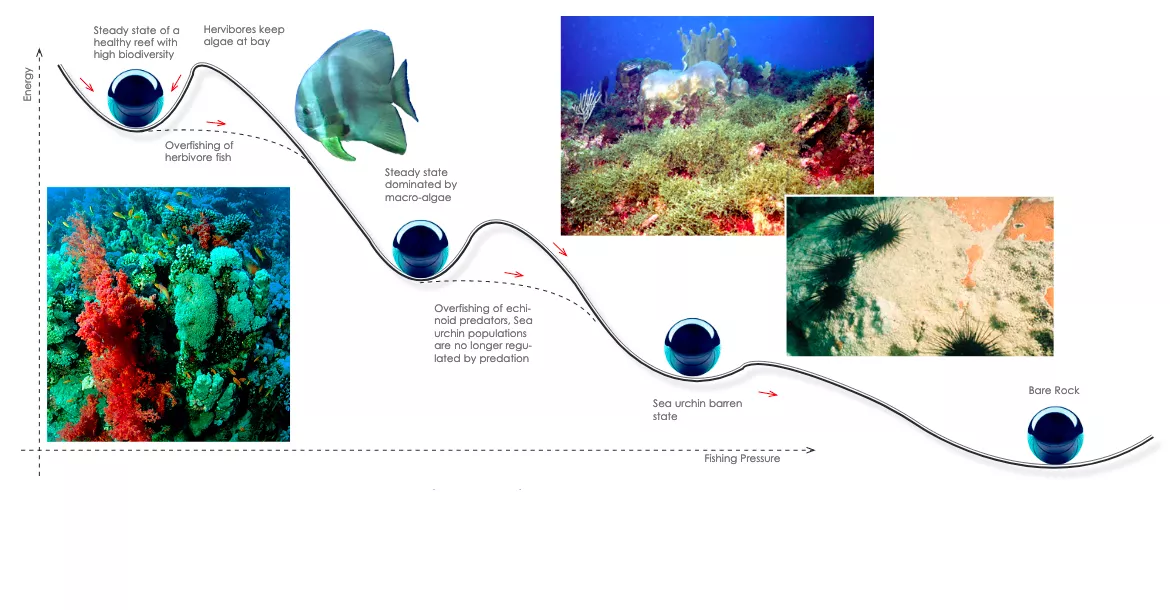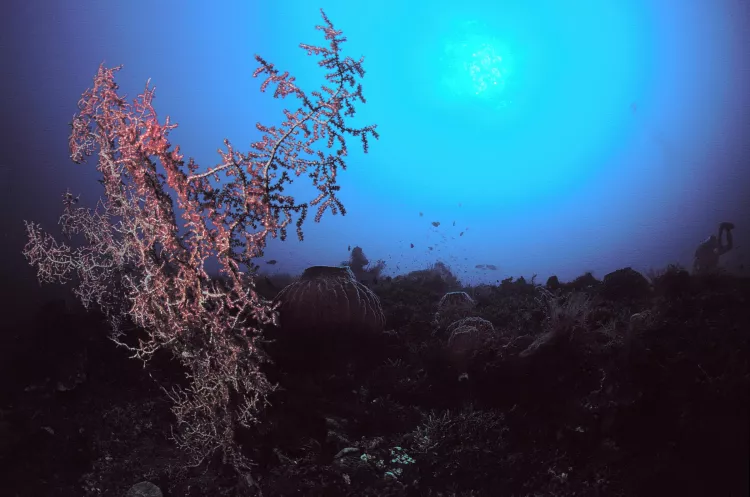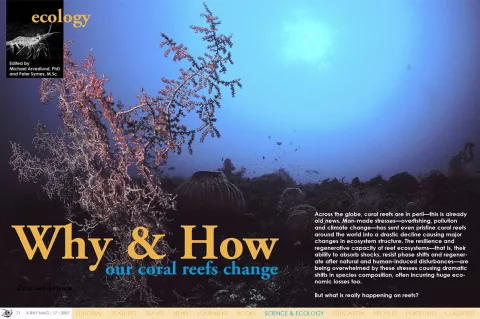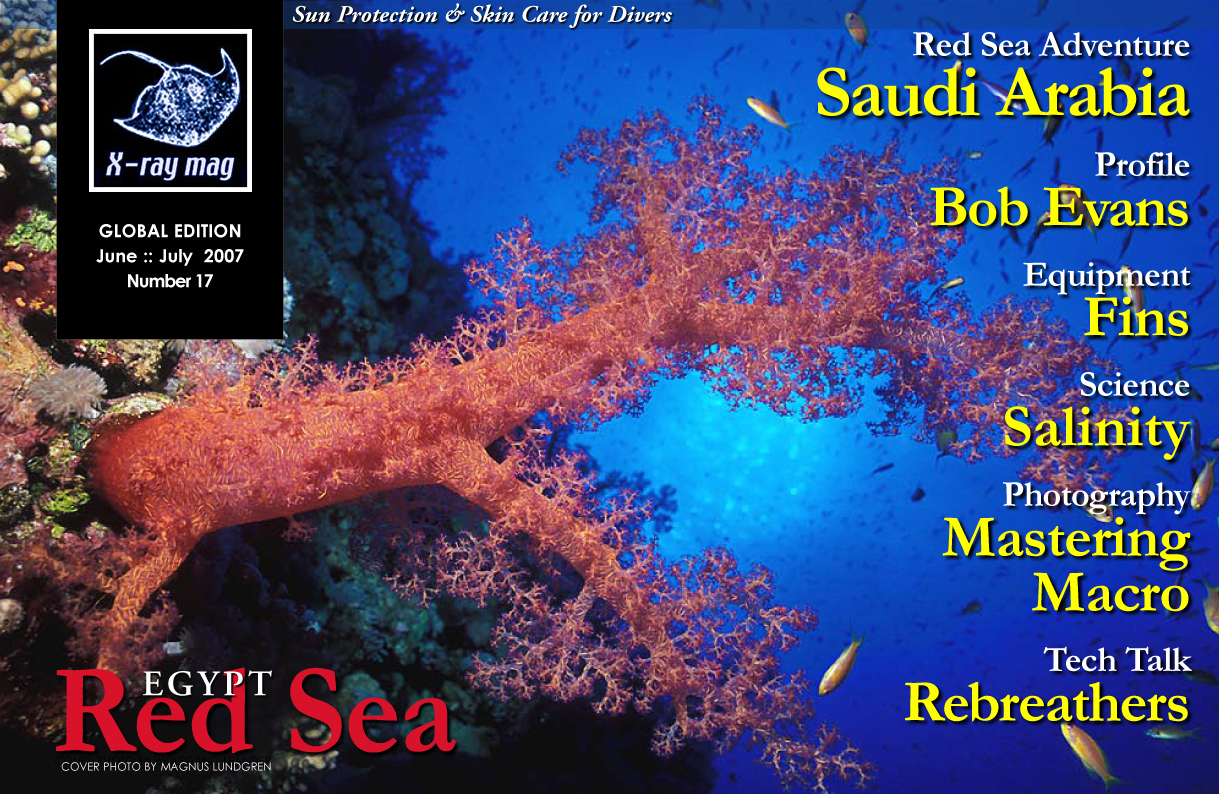Across the globe, coral reefs are in peril—this is already old news. Man-made stresses—overfishing, pollution and climate change—has sent even pristine coral reefs around the world into a drastic decline causing major changes in ecosystem structure. The resilience and regenerative capacity of reef ecosystems—that is, their ability to absorb shocks, resist phase shifts and regenerate after natural and human-induced disturbances—are being overwhelmed by these stresses causing dramatic shifts in species composition, often incurring huge economic losses too.
But what is really happening on reefs?
Contributed by
The extent to which alternate states are stable or reversible is presently not well understood. Such a process during which an otherwise stable ecosystem changes into another stable state is called a phase shift.
Stability & phase shifts
Many complex systems—ecosystems, economies—exhibits a dynamic behaviour by which they revert back to a stable equilibrium after minor or lesser pertubations from the outside. This is thanks to various buffer and corrective mechanisms, which kick in with growing effect the further away from the steady state equilibrium the system are brought. A very simple model of this principle is a ball in bowl. The ball will always come to rest in the middle. Unless, that is, you shake the bowl so violently that the ball falls out. And in that case, question is, where does the ball end up then?
Where do coral reefs end up?
Regarding coral reef ecosystems, on the other hand, there has been little success in predicting such regime or phase shifts. Mainly because the increased instability of coral reef ecosystems and their state prior to their collapses has often gone unrecognized, even on reefs which have been well studied.
This cryptic loss of coral reef resilience can manifest itself in numerous ways. For example, in the Caribbean, the collapse of many coral reefs was long preceded by dwindling stocks of fishes and increased nutrient and sediment runoff from land. In the 1950s, what prevented blooms of macroalgae from smothering the reefs was the increasing presence of a single species of sea urchin, Diadema antillarum, which grazed upon the algae.
This is an example of a buffering mechanism that kicks in acting to return the system to its steady state—the ball seeks to roll back. In the 1970s, the densities of Diadema reached extraordinarily high levels on overfished reefs, averaging more than ten individuals per square metre in shallow waters. In 1983, the magnitude and crowded conditions of Diadema populations eventually led to an epidemic, which spread throughout the Caribbean, leading to a near total collapse of the populations and precipitating macro-algal blooms that still persist today. In addition, remnant coral populations are further affected by increasingly prevalent coral disease and bleaching induced by global warming. The ball fell out of the bowl all together.
In retrospect, it is now clear that long before the present widespread loss of coral cover, many Caribbean reefs were on an unrecognized trajectory to collapse. The symptoms included loss of macro-fauna and reduced fish stocks. And as the fishes role as the dominant herbivores were gradually replaced by a single species of sea urchins, this led to destructive overgrazing and bioerosion by food-limited sea urchins, and reduced recruitment of corals. Let us look further into the dynamics of these phase shifts.
As regards to the Great Barrier Reef, inputs of sediment and nutrients from land have increased fourfold since Europeans settled, while the numbers of turtles, dugongs and other macrofauna have greatly decreased. Comparisons of adjacent reefs open and closed to fishing today indicate that the biomass of targeted reef fishes has been reduced by up to 60 percent, causing substantial changes in the abundance of their prey.
Coral cover has significantly declined over the last 40 years, reflecting the impacts of three successive major outbreaks of crown-of-thorns starfish and two large-scale bleaching events in 1998 and 2000. In 2003, more than half the reefs sampled had less than ten percent cover.
But how is coral cover linked to the fish abundance and diversity?
It has something to do with nutrient cycling. A healthy coral reef is a diverse, highly productive community able of thriving in waters that are actually exceptionally poor in dissolved nutrients.
In other words, reefs accomplish fixing high amount of carbon even in the relative absence of dissolved nitrogen and phosphate, which we all know as the main components of fertilizers. The secret to the success of the coral reefs is commonly believed to be the highly efficient recycling of nutrients in the system, particularly within the corals, where the symbiosis between the zooxanthellae algae living inside the tissues of the cnidarian host has been fine-tuned to conserving key nutrients very effectively. The algae harness energy from sunlight and fix carbon by photosynthesis. Energy from this source is provided to the polyp host in return for exclusive access to the waste-nutrients produced by the host. These wastes (N and P) function to fertilize the algae. Very little gets wasted to the outside.
Nitrogen
The most significant, and apparently “limiting” nutrient in the picture is fixed nitrogen, a critical element in the construction of all proteins. This why corals also capture prey and assimilate solid matter containing nitrogen. Somewhat paradoxically, coral reefs are intolerant of liquid nutrient enrichment as it comes, for example, in run-off from agriculture or sewers (which may also cause smothering algae blooms). Corals need to have the nutrient converted into solid form. And this is where the fish comes in.
In this context, nutrients arrive in the sea from various sources in land, some diffuse, some point-like, in the form of run-off from rivers and seepage of ground-water and discharge from sewers. Under normal circumstances, these nutrients pass through mangrove or seagrass areas before reaching the reef. It is these plants that are capable of utilizing the dissolved nutrients and incorporate them into living matter whereby it enters the food-web, passing through plankton and ultimately ending up in the biomass of fish. Of the dissolved forms of fixed N, ammonia is by far the most easily available for uptake from the water by the symbionts. Since living fish constantly excrete ammonia from their gills, it has been suggested that removing major amounts of fish from the system might ultimately deprive corals of needed nutrients.
Differences
If one looks closer at the major coral reef systems in the world, it soon becomes obvious that there are profound differences in their species richness and composition and in the dynamics and resilience of the ecosystems. For example, the Carribbean has only 28 percent of the number of fish species and 14 percent of the number of coral species found on the Great Barrier Reef. This is a striking difference, which is largely down to a biogeographic legacy of the evolutionary history of isolation and loss of taxa in the Caribbean basin. This leaves the Carribbean reefs much more vunerable to the effects of human impacts and possible catastrophic phase shifts.
Guilds & Functional groups
It is time to introduce a bit of terminology. In biology, guilds are groups of species in a community that exploit the same set of resources in a similar manner, but are not necessarily closely related taxonomically. In marine ecology, the related buzz term is functional group, which denotes a collection of species performing a similar function. Fish functional groups are generally synonymous with guilds of species from different trophic levels within a food chain (for example, predators and herbivores), reflecting their role as a major conduit for the flow of energy on reefs.
In the Caribbean, several critical functional groups are missing or represented by only a handful of species. There are, for example, no three-dimensional bottlebrush species and just one species of staghorn coral and one tall, tabular coral, elkhorn. Importantly, these are the dominant habitat-creating functional groups on healthy reefs in both the Indo-Pacific and Caribbean.
Today, many areas have effectively lost not only these two species, but also two critical functional groups and two major shallow-water reef habitats: the elkhorn palmata zone and the staghorn cervicornis zone. For fishes, the composition of functional groups on Caribbean reefs is also markedly different from that of the Great Barrier Reef. Nocturnal and diurnal planktivores, in particular, are greatly under-represented in the Caribbean.
High diversity undoubtedly provides the potential for functional redundancy. However, even in high-diversity systems redundancy in critical functional groups can be limited. What does this mean in plain language? Let’s look at a metaphor: Human cities, towns and villages. In a big city—the diverse and healthy coral reef—there are many players performing the same roles in parallel. There are many bakers, smiths, etc., all having a functional part in the fabric of society and all taking part in the flow of the economy. If one goes out of business, there are others to take over, the society doesn’t collapse; it adapts. You find another bakery if the one on the corner goes out of business or go to the supermarket instead. This constitutes the functional redundancy in the system.
But if all the bakers close, and the supermarket stops stocking bread, and it is essential to your survival, then what do you do? You can have a town full of other sorts of stores, but you can’t buy bread at a bookstore or a plumber’s. That’s when you have a high-diversity system with limited redundancy in critical functional groups. You move to another town—or die.
And this is the problem for many small villages in Europe. They hang on while all their shops close, one by one, since they can’t cope with the competition from elsewhere. Once they lose their last supermarket, school, post office, pharmacy, bakery—which together constitute a form of economical functional group—the town starts to die as it stops functioning, and people have to leave. It is the same case with reefs in our case story with the sea urchins, following the depletion of fishes. They became the principal herbivores on many Caribbean reefs, and they prevented the rapid phase shift to dominance by macro-algae that was precipitated by the die-off of Diadema.
Functional Groups & Resilience
Three functional groups play different and complementary roles in preconditioning reefs to permit recovery of corals. These three groups—bioeroders, scrapers and grazers—are a critical source of both resilience and vulnerability to phase shifts.
Bioeroding fishes remove dead corals exposing the hard, reef matrix for settlement of coralline algae and corals.
Scrapers directly remove algae and sediment by close cropping, facilitating settlement, growth and survival of coralline algae and corals.
Grazers remove seaweed, reducing coral overgrowth and shading by macro-algae.
The extent to which reefs possess these functional groups is central to their capacity to resist phase shifts, regenerate and retain critical functions in the face of disturbance. A key element in resisting phase shifts to degraded alternate states is the maintenance of successful larval colonization by the full range of coral functional groups characteristic of the region. If coral reefs are to resist phase shifts after disturbance, it is imperative that critical functional groups of fishes, corals and other taxa are actively managed and sustained.
Meeting the challenge
Much has been lost, and some of it forever, but much remains to be saved. Management of functional groups represents a radical departure from previous management philosophies. For example, wise management of herbivorous fishes can facilitate the regeneration of reefs after large-scale disturbances such as bouts of bleaching or disease that are impossible to regulate locally.
But it is imperative to scale up management and governance systems to secure the future of functional groups and their roles in supporting the resilience of coral reefs. Also the management of no-take areas (NTAs)—where fishing and other human activities are prohibited—are an increasingly prevalent approach to coral reef management. If they are adequately enforced, NTAs provide a spatial refuge from harvesting. Importantly, such protection may also permit critical functional groups to persist, and thus contribute to local ecosystem resilience.
However, even the largest NTAs in the world are not self-sustaining, because they are still too small relative to the scale of natural and human disturbances, and to the dispersal distances of many larvae and migrating adults. The rate of establishment and size of NTAs as a tool for resilience management needs to be hugely increased. The expansion of NTAs in 2004 from five percent to 33 percent of the Great Barrier Reef Marine Park in Australia, with a parallel focus on improving water quality, provides a good model.
Choosing the right areas to protect
Hotspots, areas of exceptional species richness, are one of the most frequently identified targets for the protection of marine ecosystems. However, there are several lines of evidence to suggest that cool spots, areas of low species richness, are more vulnerable. Low-diversity reefs, such as in the Caribbean Basin, the Eastern Pacific and many high-latitude or remote locations in the Indo-Pacific have low functional redundancy where functional groups may be represented by a single species. As explained above, in these systems even minor changes in biodiversity can have a major impact. ■



























